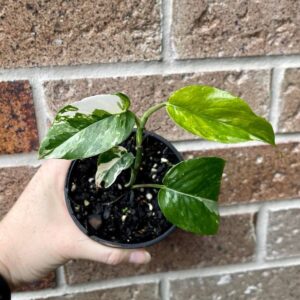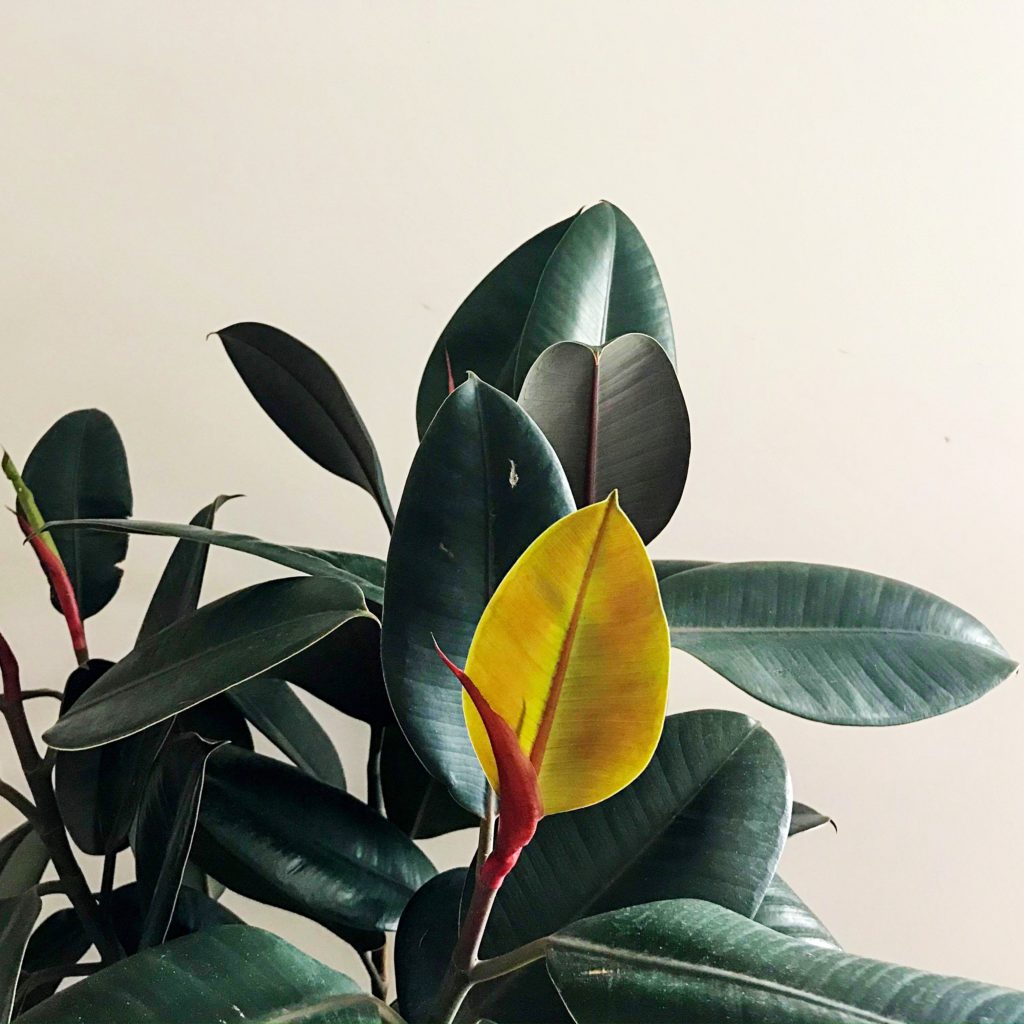Epipremnum Pinnatum Variegata
The Epipremnum Pinnatum Variegata is a trailing/climbing plant with beautiful white and green variegated foliage. As a juvenile plant, the leaves are green, long, oval/arrow shaped with white variegation. When the plant starts to mature, the leaves start to get fenestrations/splits. This plant is quite easy to care for and would be a stunning plant to add to your collection. The Epipremnum Pinnatum Variegata is part of the Araceae family and native to Asia, Papua New Guinea and Australia. This plant is usually found in tropical forests where it grows up trees and other plants.

Epipremnum Pinnatum Variegata Quick Overview
| Full Size | Up to 65 feet |
| Light | Bright indirect light |
| Temperature | 65ºF-80ºF (18ºC-27ºC) |
| Humidity | Above 50% |
| Cost | $$ |
| Care Level | Easy |
| Toxicity | Toxic |
Size
The mature size of a Epipremnum Pinnatum Variegata can reach between19 to 65 feet in length. A mature leaf can reach between 11 to 19 inches in length. These sizes are really only commonly seen in their natural habitat. When kept indoors, you can expect your Epipremnum Pinnatum Variegata to reach about 8-10 feet.
You can grow this plant up a trellis or you can have it in a hanging basket. Providing it with a trellis or pole for it to climb will help to encourage those larger leaves. Providing your Epipremnum Pinnatum Variegata with a living environment as close to its natural environment as you can will help encourage the plant to grow to its full potential.
Light Requirements
Epipremnum Pinnatum Variegata will grow best when in bright indirect lighting. This plant requires at least 6 hours of light per day. Having your plant positioned in a spot where it receives some morning sunlight should be okay however, you should try and avoid any direct afternoon sunlight as this can burn the foliage.
This is because the morning sunlight isn’t as harsh as the afternoons rays. A sign that your Epipremnum Pinnatum Variegata isn’t receiving enough light is if the plant is becoming leggy and losing its variegation.
Adding a blind or curtain to your window will help to defuse the harsh sunlight to avoid burning the plants foliage. Alternatively, if you can’t seem to find that perfect spot in your home, you can always use grow lights.
Just like direct sunlight, if your plant is sitting too close to the grow lights, they will burn the foliage. Keeping a safe distance of at least 60cm between your plant and the light will avoid any trouble.
Temperature
The ideal temperature for growing Epipremnum Pinnatum Variegata is between 65ºF-80ºF (18ºC-27ºC). Since this plant is from tropical climates, it loves warm temperatures. If the temperature is expected to drop below 50ºF (10ºC), you should move your plant to a warmer spot in your home.
You should also try and keep the plant away from drafts windows, doors and heating and cooling vents to avoid any large fluctuations in temperatures. When exposed to temperatures outside of this range for prolonged periods of time, your Epipremnum Pinnatum Variegata can have stunted growth.
Humidity
Not only does this plant love warmth, it loves humidity. Epipremnum Pinnatum Variegata will thrive when kept in a humidity environment above 50%. Keeping your plant in a spot where the humidity is too low can make it more vulnerable to pests and diseases. A sign that your Epipremnum Pinnatum Variegata may require more humidity is spotted and/or browning leaves.
Providing a high humidity for your plants will encourage bigger and healthier growth. There are a few thing you can do that can help bump up the humidity in your home. The things you can try are:
- Misting your plants
- Pebble trays
- Grouping plants together
- Humidifier
You can read more about increasing humidity in your home here.
Watering Requirements
You can expect your Epipremnum Pinnatum Variegata to require moderate watering (at least once a week). This will change throughout the cooler months when the temperatures and amount of sunlight is changing.
Before watering, you should check the top 2 inches of soil with your finger to feel if it’s dry. If the soil is dry, you should give your plant a drink. Checking the soil before watering your plants is important as it will help to avoid over-watering. A sign that your Epipremnum Pinnatum Variegata needs water is spotted and/or wilting leaves.
When it comes to watering houseplants, you need to be cautious of over-watering. Excess water causes the soil to become waterlogged and can start rotting the roots.
Rotted roots can no longer take in any water or nutrients to the plant. This can then cause fungus issues, pest problems and root-rot. A sign that your may have over-watered your Epipremnum Pinnatum Variegata is drooping leaves and/or leaf drop.
Fertilizing requirements
You should fertilise your Epipremnum Pinnatum Variegata monthly during the growing period (Spring and Summer). You can cut back on fertilising during the cooler months (Winter and Autumn) when growth slows.
Applying fertilizer while your plants aren’t using all the nutrients in the soil can cause salt build up and root burn. Fertilizing your plants will give them the essential nutrients they need for promoting and maintaining new and healthy growth.
The best fertiliser to use for Epipremnum Pinnatum Variegata would be a balanced all purpose fertiliser diluted to half strength. An easy and a great alternative to liquid fertiliser would be a slow release fertiliser.
Slow release fertilisers don’t need to be applied as often and the plant can take the nutrients as it needs them. Apply the slow release fertiliser as per the instructions on the packet.
Something you need to look out for when fertilising your houseplants is over-fertilising. Over-fertilising your Epipremnum Pinnatum Variegata can burn the roots and foliage. If you think you’ve over-fertilized your plant you can either change the soil or rinse the fertilizer out of the soil. You will notice a change in the water colour once the fertilizer has been rinsed out.
For more information on fertilizing houseplants click here.
Soil Requirements
Epipremnum Pinnatum Variegata like to be in a rich, well draining soil. To create a well draining soil, you can use a mixture of potting mix, orchid bark, perlite, peat moss and charcoal.
These ingredients help to create better drainage and aeration. Air flow is important in potting soil as it allows the plants roots to breath. Not having enough oxygen to the roots can eventually cause them to start rotting.
You can add other organic materials like coco coir, mulch chunks or coconut husk to the soil to help restrain moisture. When it comes to potting soil, you want to use a mix that will help hold moisture but won’t keep the soil soggy. Adding garden compost or worm castings to the soil will add more richness that Epipremnum Pinnatum Variegata will love. Using the correct soil mix can help to avoid common mistakes like over-watering.
Diseases & Pests
The common pests that you may encounter on your Epipremnum Pinnatum Variegata are spider mites, aphids, scale and mealybugs. For more information on identifying and treating common houseplant pests click here. The most common diseases you may encounter are root-rot and leaf spot.
The best thing you can do when it comes to pests on houseplants is to try and avoid any pest infestations from starting. There are a few things you can do that will assist in preventing any pest infestations and these things are:
- Checking new plants for pests or isolating new plants for up to a week.
- Check your plants every few days for pests.
- Trim off any dead or dying leaves.
- Wipe down leaves if you notice them getting dusty.
- Keeping your plants healthy. A healthy plant will be able to handle an infestation better than those that aren’t as happy.
- Isolate any plants that have pests.
Following this will assist in keeping pests away as well as catch them early on before any severe infestations are able to start. Keeping plants healthy and in the correct living environments can help to deter any pests from invading your plants.
Toxicity
Epipremnum pinnatum Variegata contain Calcium Oxalate Crystals which are toxic to both humans and pets if ingested. If any part of the plant is ingested, symptoms may include swelling of the oesophagus, GI tract and mouth. If ingested by pets, the symptoms may include vomiting, lack of appetite, drooling and pawing at the mouth.



